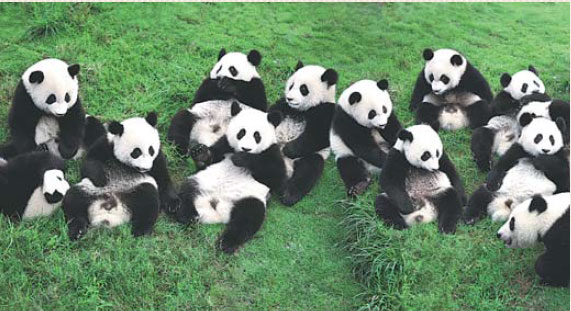Kung Fu Panda brings Sichuan into limelight
|
Happy panda families in a local reserve. Sichuan is renowned as the birthplace of the rare animal. |
Viewers of the movie Kung Fu Panda 3, released in China and the United States in January, were interested in the fictional Panda Village to which the hero Po returns with his long-lost father.
Some foreign viewers said they were keen to visit Qingcheng Mountain in Sichuan province because the scenery of the Panda Village amazed them.
They said the mountain, as portrayed in the movie, seems to have a peaceful environment. In the movie, Po says he can only find inner peace on the mountain, and that he derives the power he uses in kung fu from there.
Raman Hui, director of the promotional music video for Kung Fu Panda 3, said the scriptwriting team visited Sichuan many times for inspiration.
It was not the first time the elements of Sichuan were featured in Kung Fu Panda.
When Kung Fu Panda 2 made Chinese audiences roar with laughter after hitting the mainland screens in May 2011, viewers saw the animated flick incorporate many cultural icons of Chengdu.
Qingcheng Mountain, spicy dandan noodles, mapo tofu and hot pot all appear in Kung Fu Panda 2, chief of the city's information office Xiong Yan said.
The introduction of the Sichuan elements inadvertently fits into a larger trend in which Hollywood is actively courting Chinese audiences' interest.
DreamWorks Animation SKG Inc's CEO Jef rey Katzenberg had expressed concern about the pandas' habitat when Kung Fu Panda premiered in Cannes, France, three days after the quake in 2008.
He and his team arrived in Chengdu for a two-day stay in October 2008. They visited the Chengdu Research Base of Giant Panda Breeding and Qingcheng Mountain.
Katzenberg and his crew also sampled local specialties, such as dandan noodles. The CEO enjoyed his stay so much that he delayed his departure by private plane by two hours, Xiong said.
Katzenberg proposed including Sichuan elements in the sequel as a result of the trip. Their experiences of petting a newborn panda - later named Ah Bao after the film's protagonist - at the Chengdu breeding base served as the inspiration for the development of Po's character in the second film, Xiong said.
"It was in the base that the baby panda inspired the Kung Fu Panda character Po and that we got the inspiration for the image of Po's master, shifu, from a red panda," the production director of Kung Fu Panda 2 Raymond Zibach said.
Qingcheng Mountain provided abundant inspiration for DreamWorks' creative team. Upon arriving at the mountain's base, the team was greeted by about 50 disciples of the Qingcheng martial arts sect, who performed shadowboxing.
Peacock Lord Shen's graceful and fluid shadowboxing style is believed to come from the Taoist master Liu Suibin, who performed for the team.
The visitors were dazzled by the mountain's lush greenery and murmuring streams. Director Jennifer Yuh Nelson described the place as the Peace Valley.
They said they would likely include the mountain in the sequel. The wooden hut in the film is based on the likeness of Qingcheng's structures and the mountain's Pavilion of Nature is featured at the film's end.
The pavilion is very interesting and inspiring, as it combines natural material with traditional architectural styles, Zibach said.
The Chinese characters for the famous mountain, which inspired many of the film's verdant landscapes, appear twice in the animated work.
Katzenberg, who believed China will be the world's largest film market in a decade, said the Kung Fu Panda franchise was a love letter from Hollywood to China.
The subtle incorporation of Chinese culture has become a stepping stone for Hollywood to enter the Chinese market, he said.
"The Chinese elements in Kung Fu Panda were well received by Chinese audiences, and the film broke the Chinese box office record for highest-grossing animated feature," Katzenberg said.
Kung Fu Panda 2 provides a more thorough depiction of Chinese culture, which has not always been done in Western movies, according to South Korean director Park Jin Bum.
Chengdu's publicity coup has served as a role model for Chinese cities to use Hollywood blockbusters to build their image, Xiong said.



















